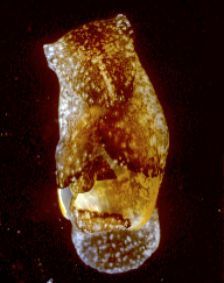
Haminoea vesicula
(Gould, 1855)
Order: CEPHALASPIDEA
Superfamily: HAMINOEOIDEA
Family: Haminoeidae
DISTRIBUTION
Eastern Pacific from Gulf of California to Alaska
PHOTO
Morro Bay, California in 1971. Photo: Gary McDonald
Reference:
• Gould, A.A. (1855). Catalogue of shells collected by W.P. Blake, with descriptions of the new species. Appendix, part 2, pp. 22-28 in Blake, W.P. Preliminary geological report of a reconnaissance and survey in California in connection with explorations for a predictable railway route from the Mississippi River to the Pacific Ocean in 1853 by Lt. R.S. Williamson. Washington D.C.: U.S. House of Representatives, Doc. 129, 33rd Congress, 1st session.
Rudman, W.B., 2001 (November 19) Haminoea vesicula (Gould, 1855). [In] Sea Slug Forum. Australian Museum, Sydney. Available from http://www.seaslugforum.net/find/hamivesi
Related messages
Haminoea vesicula from Puget Sound, Washington
August 31, 2006
From: Wallace Davis
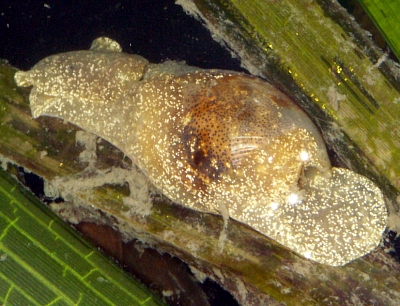
I recently came across large numbers of the nudibranch in the attached photo. They were living on eel grass, probably eating hydroids which were abundant, and laying lots of eggs. Can anyone identify it.
Locality: Fisherman Bay, Lopez Island, 1" - 1' (minus tide with 1' water, Washington, North Puget Sound, 9 August 2006, Muddy bay. Length: estimate 1 1/2 inch. Photographer: .
Thanks
Wallace Davis
wdavis@verizon.net
Davis, W., 2006 (Aug 31) Haminoea vesicula from Puget Sound, Washington. [Message in] Sea Slug Forum. Australian Museum, Sydney. Available from http://www.seaslugforum.net/find/17553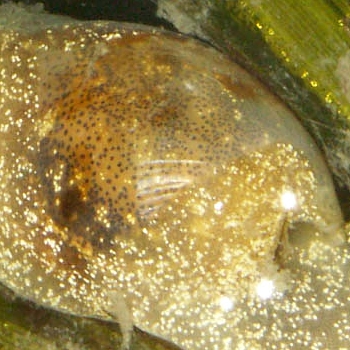
Hi Wally,
Yes, this is the time of year we see many Haminoea out laying eggs. I am observing huge numbers of the sister species, Haminoea japonica, on the green algae Ulva, in Gig Harbor at the southern end of Puget Sound.
I would have to ID your specimen as Haminoea vesicula (Gould, 1855) because of the specks on the mantle tissue we can see through the transparent shell, although yours might be H. japonica also. Can you send us a photo of the eggs?; The two species differ internally, but H. japonica has both planktonic and direct development larval strategies depending upon food availability.
Haminoea japonica from your area was originally thought to be a new species, and was named Haminoea callidegenita. We look forward to some egg photos.
Thanks,
Dave Behrens
Re: Haminoea vesicula f rom Canada
June 2, 2002
From: Sandra Millen
Hi Bill,
I think the recent photo by Marli is H. vesicula. This is the only species I have seen in B.C. although I have seen the others further to the south. It is extremely common in muddy bays in and around eelgrass beds. H. vesicula has a very small indent in the mid-posterior line of the cephalic shield, H. virescens has none and the shell is greenish, H. callidegenita has a deeply bifurcate posterior shield. They are all very different internally.
Sandra
millen@zoology.ubc.ca
Millen, S., 2002 (Jun 2) Re: Haminoea vesicula f rom Canada. [Message in] Sea Slug Forum. Australian Museum, Sydney. Available from http://www.seaslugforum.net/find/7141Thanks Sandra,
Bill Rudman
Haminoea vesicula? from British Columbia
May 29, 2002
From: Marli Wakeling
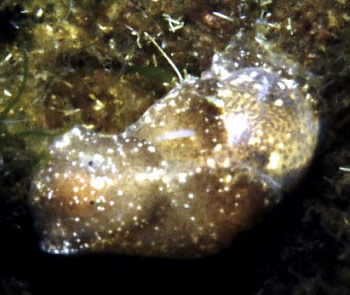
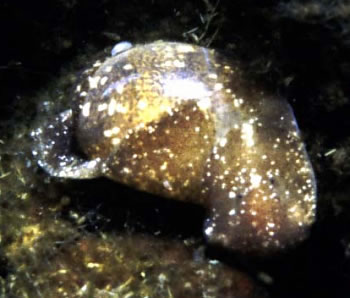
Hi Bill,
I think that this is Haminoea vesicula, but I'm not positive. Could you verify this as the correct identity, please? There were many of these animals congregating in the shallows.
Dive Site: Miller Rock, Agamemnon Channel, Sechelt Peninsula, British Columbia.
Depth: 15 feet
Length: 15mm
Date: April 7, 2002
Photo by: Marli Wakeling
Marli
scubamarli@excite.com
Wakeling, M., 2002 (May 29) Haminoea vesicula? from British Columbia. [Message in] Sea Slug Forum. Australian Museum, Sydney. Available from http://www.seaslugforum.net/find/6892Thanks Marli,
You are right to be slightly cautious about identifying this animal. Apart from H. vesicula, both H. callidegenita and H. virescens live in your region and they don't seem to be too easy to separate from photos of the living animals. If anyone can give us some clues on distinguishing these three they would be very welcome.
Bill Rudman
Haminoea vesicula from Lake Merritt
November 22, 2001
From: Katie Noonan
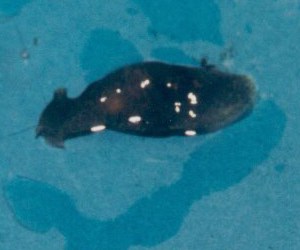
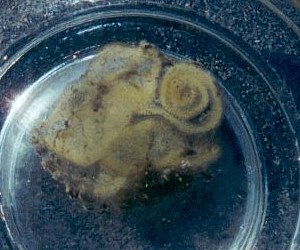
Dear Bill,
Here are snapshots I took of the "sea hare" in Lake Merritt, Oakland CA. I hope this will help identify it. It is in a 6" fingerbowl in the seahare and eggs photo.
Thanks,
Katie
KTNoon@aol.com
Noonan, K., 2001 (Nov 22) Haminoea vesicula from Lake Merritt. [Message in] Sea Slug Forum. Australian Museum, Sydney. Available from http://www.seaslugforum.net/find/5710Thanks Katie,
To those of you who haven't followed this conversation, Dave Behrens has identified this as Haminoea vesicula
Bill Rudman
Re: Hermaphroditism & evolution
November 21, 2001
From: Dave Behrens

Bill:
I have communicated with Katie and she has shared photos of her "sea hares" with me. Her critter turns out to be the cephalaspidean, Haminoea vesicula (Gould, 1855). The attached photo of this species was taken by Gary McDonald from Morro Bay, California in 1971, where it is very common.
An additional comment about Katie's collection area. Lake Merritt is a large lake in the center of downtown, Oakland, California. This is the site of the early collections of, introduced species expert, James T. Carlton, and supports quite an opisthobranch population. The "lake" is actually a arm off the eastern shore of San Francisco Bay and is subjected to tidal movements which "flush" it twice a day, keeping its saltwater fish and invertebrate population healthy and happy.
Dave Behrens
dave@seachallengers.com
Behrens, D.W., 2001 (Nov 21) Re: Hermaphroditism & evolution. [Message in] Sea Slug Forum. Australian Museum, Sydney. Available from http://www.seaslugforum.net/find/5674Thanks Dave,
Lake Merritt sounds just the right place for a species of Haminoea - as long as they are in a sheltered locality, they seem to be fairly easy to please. I think I have mentioned somewhere else in the Forum about finding a thriving population of the New Zealand species, H. zelandiae, on the roof of 4 storey waterfront building, which was flooded with seawater and used as a cooling pond for a refrigeration plant.
Best wishes,
Bill Rudman
Hermaphroditism & evolution
November 1, 2001
From: Katie Noonan
I am a high school science teacher in Oakland, California, USA. My students and I came upon gobs of sea hares in Lake Merritt (a tidal lagoon in the center of Oakland). Egg ribbons were dense around the shore. The odd thing is that sea hare breeding has not been noticed by our resident Lakekeeper in several years. The lagoon, which undergoes wild salinity changes over the year, is very saline at this time, at least 35 ppt.
We have an adult and some eggs in a tank in the classroom. The adult seems to be hanging on, eating algae and moving. The eggs are developing also. A species Aplysiopsis? was listed among Lake Merritt fauna, and I assume this is what we saw. It is about an inch long, brown with simple flaps over its back - no frills. I photographed it and will send a scan when it is developed.
Where can I find something about the evolutionary maintenance of hermaphroditism in these mass-breeding creatures?
Katie
ktnoon@aol.com
Noonan, K., 2001 (Nov 1) Hermaphroditism & evolution. [Message in] Sea Slug Forum. Australian Museum, Sydney. Available from http://www.seaslugforum.net/find/5583Dear Katie,
I look forward to seeing the photos. If you have one of the egg masses that would be interesting as well. If your animals are sea hares then they won't be Aplysiopsis. Although the name Aplysiopsis is very similar to the Sea Hare genus Aplysia it belongs to a quite distinct group off sea slugs called the sacoglossans which feed by sucking the cell contents from algae. If you look at the Species List and scroll down to the ORDER Sacoglossa, you will find many example of that group. You will find a species of the genus Aplysiopsis from Calfornia on the list, Aplysiopsis oliviae, and a Japanese species, for which we have better photos, Aplysiopsis minor.
I suspect from your dscription that you have a Sea Hare, but at 1 inch long (aprox 25mm), it is very small to be laying eggs considering that the two common Californian Sea Hares, Aplysia californica and Aplysia vaccaria grow to a very large size.
Now to your question about hermaphroditism. Natural selection and the maintenance of characters is an interestng topic but I don't know if it really applies to hermaphroditism in Sea Hares. There are some features which are set so deep in a species genetic makeup that change is very unlikely to occur. Hermaphroditism is a state acquired very far back in the evolutionary line to which all sea slugs and land snails and slugs belong. There has of course been debate on why hermaphroditism was acquired, but unfortunately it happened so long ago, we can only speculate about its origins in the pulmonates and opisthobranchs.
Best wishes,
Bill Rudman
